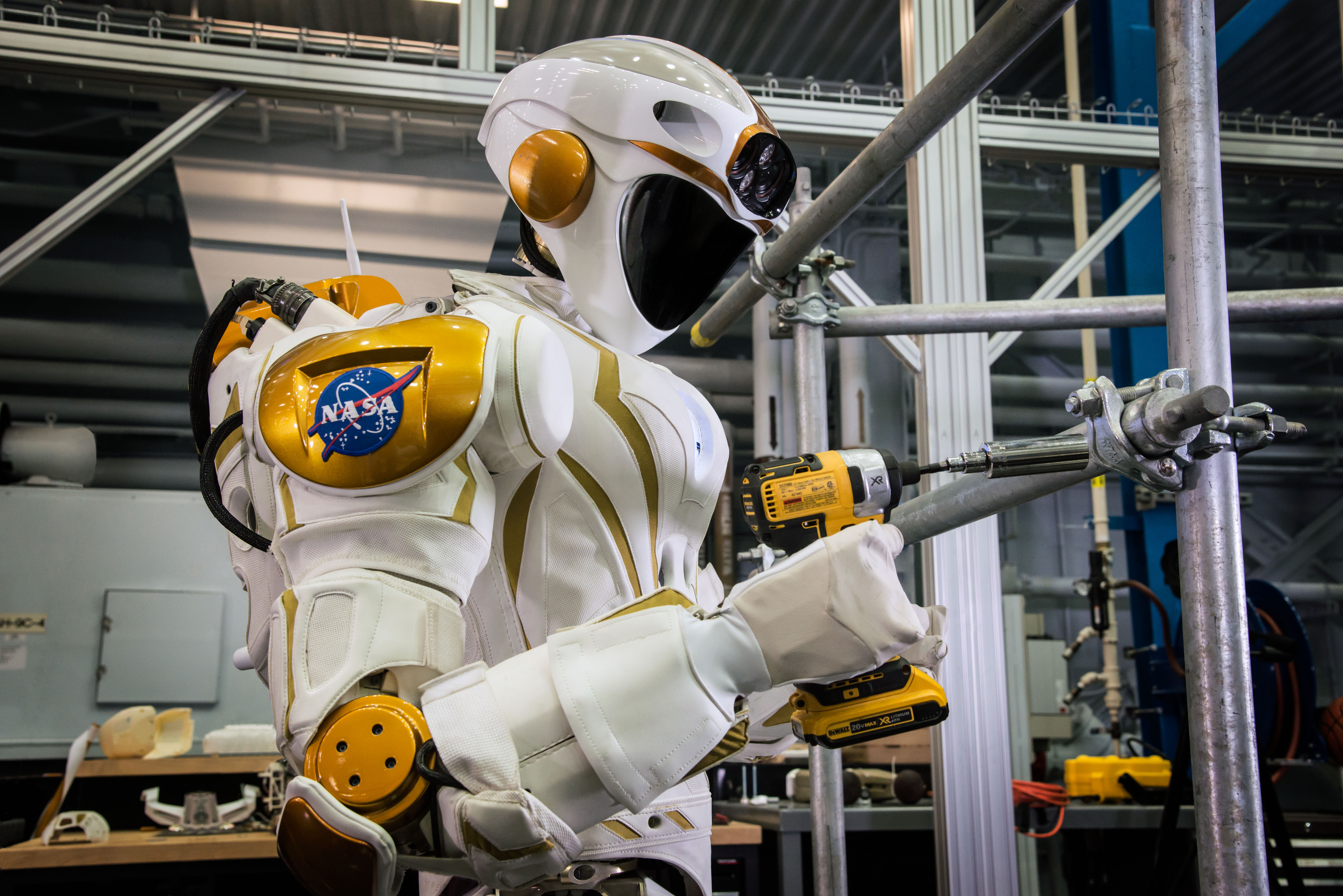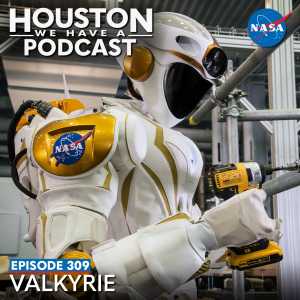
From Earth orbit to the Moon and Mars, explore the world of human spaceflight with NASA each week on the official podcast of the Johnson Space Center in Houston, Texas. Listen to in-depth conversations with the astronauts, scientists and engineers who make it possible.
On episode 309, Johnson’s deputy team lead of dexterous robots Evan Laske describes the design and ambitions of the humanoid robot Valkyrie. This episode was recorded on September 8, 2023.
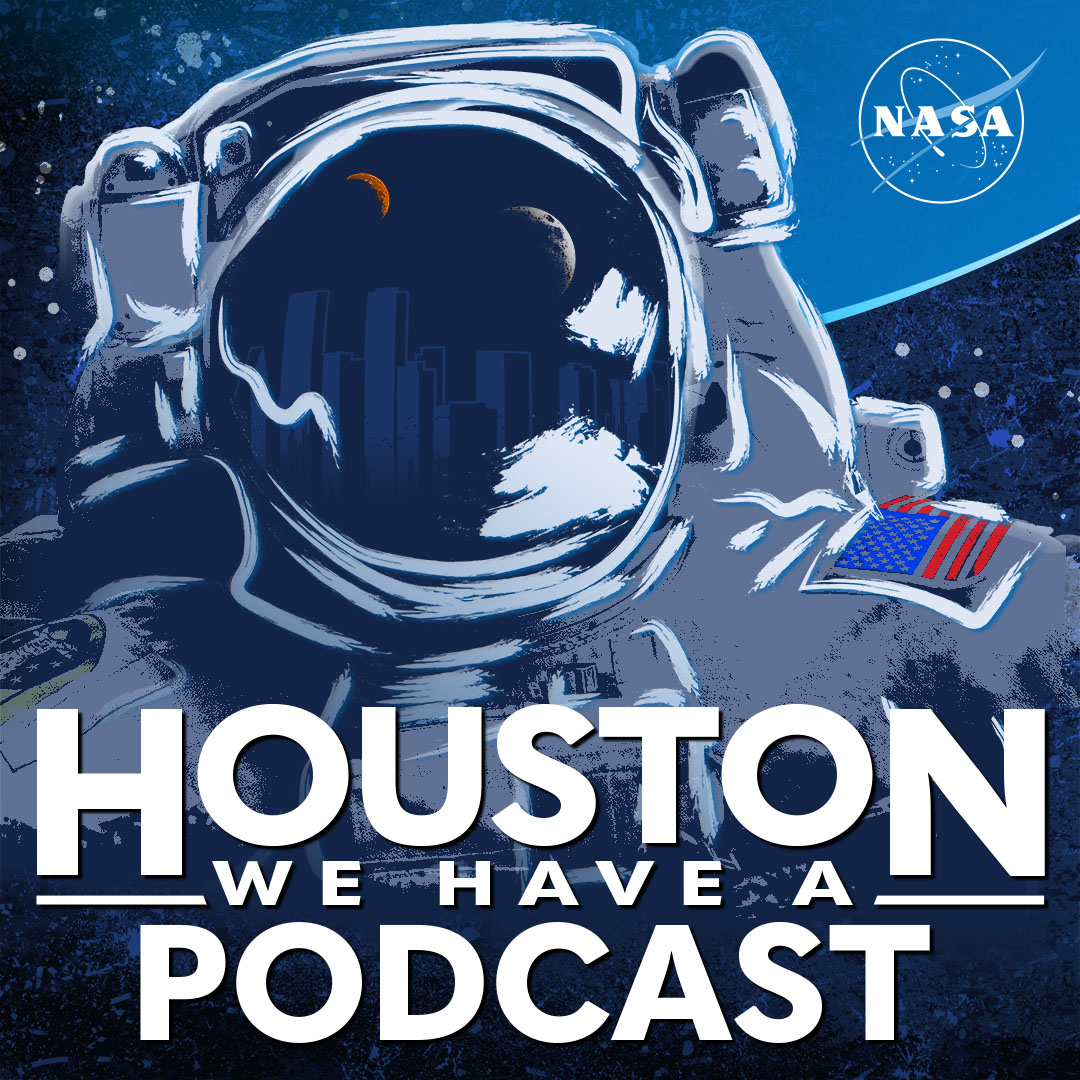
Transcript
Host: (Gary Jordan): Houston, we have a podcast! Welcome to the official podcast of the NASA Johnson Space Center, Episode 309, “Valkyrie.” I’m Gary Jordan, I’ll be your host today. On this podcast, we’re bringing in the experts, scientists, engineers, astronauts, all to let you know what’s going on in the world of human spaceflight and more. On this episode, we’re going to talk about a humanoid robot. Humanoid means it walks like a human and kind of looks like a human. Imagine Iron Man, but it’s made of metal and electronics and built for a versatile range of functions to best emulate human capabilities with no humans inside. Recently, NASA announced collaborative agreements with companies around the world to utilize NASA expertise for bringing humanoid robots into industry. Why? Well think of something like an offshore oil rig for example. When a facility is built to be operated by humans with levers, switches, dials, and doors, but there are no humans there to attend to maintaining a facility, whether it’s uncrewed or potentially hazardous, what better capability than a one-stop shop for having a full swath of human capabilities without risking human lives than a robot shaped like a human?
Why NASA? Well, who’s going to take care of home sweet Martian home when the astronauts are away? Knowing that continuous human presence on the Martian surface is likely not immediately achievable after those first boot prints. It’s a capability worth exploring and maturing. To help explain Valkyrie, the design, the ambitions of the robot, we have the Deputy Team Lead for dexterous robots here at NASA Johnson Space Center, Evan Laske. Alright, let’s get right into it.
[Music]
Host: Evan Laske, thank you so much for coming on Houston We Have a Podcast. Welcome, man.
Evan Laske: Well, hey, thanks for having me. Yeah, I was just thinking about how this is one of the few times we get to work together.
Host: I know, we were co-ops together. I remember some of our first weeks as full-time at NASA, seeing each other. But yeah, our paths have not crossed professionally so much. We just live in d different worlds, man. I was ISS (International Space Station) for a long time. You’ve always been in engineering though, right?
Evan Laske: I mean, obviously going back to co-op days. I rotated through flight ops and well, mission ops at the time. But ever since about 2011, well 2010. I came into engineering and have been there ever since.
Host: Yeah. You have a history mostly with dexterous—am I saying that right? Dexterous robotics.
Evan Laske: Dexterous robotics. Yep.
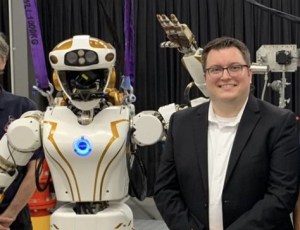
Host: Dexterous robotics. So you’ve been especially there. And this is nice. We should clarify this for our listeners cause our listeners can be more familiar with this. We’ve had a lot of previous co-ops or Pathways interns. You and I are old enough to still call it co-ops, but it’s a rotational thing. So you get a lot of opportunities to try different things. And you did a rotation with the dexterous robotics folks, right?
Evan Laske: Yeah. So in my co-op time, I came in and I first started back in ISS. So this was in the OSO or Operation Support Officer group. So they were really cool cause they fix everything on station basically. I got a chance to look at a lot of different systems throughout the ISS. Then I moved over to the avionics engineering division and worked a lot on sensor acquisition stuff. Then I moved over into our Robotics Systems Technology Branch here. And that’s basically where I’ve been ever since. So I’ve touched a ton of different projects. Robonaut 2 you may have seen a lot about before.
Host: We haven’t dove too deep into it, in this podcast. But yeah, if you see it, and if you’re familiar with NASA at all, you’ll know it. It looks like Boba Fett pretty much.
[Laughs]
Evan Laske: There was some inspiration, some artistic inspiration there. A lot of spinoff stuff from that. So I worked on bringing some of the technology from the hands to wearable robotics, with the Roboglove that’s actually now been patented, licensed. It’s actually a commercial product as well. So the technology transfer has gone through there. So that was really cool to be involved with. A lot of adapting that to the spacesuit glove. Then with Robonaut 2, I was able to work through sending that to some of our partners and work with them as well as I started getting into, project management and technology development projects specifically in the early career initiative projects. So that was all related to dexterous robotics. So that really set me up well for where I’m at now, which is I’m the deputy lead for the dexterous robotics team here within the Robotics Technology Branch.
Host: I want to go into exactly what that means, but to take a step back. to get you to that lead. You’ve been with the dexterous robotics group, committed and worked your way up to certain levels of responsibilities. But funny enough, you weren’t the first choice out of the co-op rotation. I love that you love to tell this story.
Evan Laske: Yeah well, so I like to talk that, especially when people, when interns—you know, there’s a lot of worry sometimes about whether or not, especially early on in your career, whether or not you feel good enough or imposter syndrome kind of things. And I usually like to let them know a little bit of encouragement because I wasn’t. So in the co-op program, when they hire people, you know, they hire somewhere between 10 and 20 a semester, right? And I was 21st on that list. So somebody actually had to turn down the offer for me to get down here. And so now I’ve had this almost 15-year career since I started as a co-op. And I’ve gotten to touch so many different things, invented things, and now have led technology projects, you know. So it’s been really cool to be able to tell that. You know, everyone has a different path, right? And so I got the opportunity to come here, but there are other folks that have different paths that get them to where they end up.
Host: The fact that I think you’re committed to it and when you got selected, you’re like, now you can take on more responsibilities and all the things you’ve done have been crazy. You say you invented stuff. What did you invent?
Evan Laske: Well, I mean, with some of the tech dev projects, what’s great about doing tech dev is you get to think about new ways of doing things. And generally, new ways of doing things are novel, and so they’re able to be patented. And especially ones that are able to be commercialized. I think I’ve got five now.
Host: Five patents?
Evan Laske: Yes. Yeah. So all related to a lot of the Roboglove development. What’s cool about those is that they’re a collaborative and team effort. And so, you know, it’s not just me, it’s not just them. You know, the team usually comes up with solutions to problems and we all get to share in that which was really cool.
Host: Let’s start with Roboglove to really help us to dive into—let’s start with dexterous robotics. Because this is where you’re deputy lead but I want to get a sense of what that is. Roboglove I feel like is a good example of that, right? Cause it’s a hybrid, it’s not necessarily a humanoid robot. It’s more of a dexterous assistance? Is that a good way of—? I’m messing it up I feel like.
Evan Laske: No worries. You know, so dexterous robotics is basically think of any time generally a robot interacts with the world. So there are a lot of different robotic archetypes. Some that, you know, you might consider a self-driving car, just a robot on its own, but it’s not dexterous, it doesn’t interact with the world, move things around or things like that, right? And so you can kind of think of any dexterous robot as something with an arm. Something that manipulates objects in space, moves them around, you know, rearranges them, builds things, those kinds of things. The space station arm is an example of a somewhat dexterous arm.
Host: Canadarm2? Or Dextre? Or both?
Evan Laske: Yes, well both. Yeah. They are different pieces of that of that puzzle. And so we’re really focused on what, on that part, the manipulation aspects of robotics. There are a lot of groups around NASA that look at other aspects of the problem. Robotics is a lot like saying spaceflight. There’s a lot that goes into it.
Host: I see.
Evan Laske: You know what I mean? There are sort of specialties in that domain. And so ours is mostly on manipulation-related things. Roboglove is unique because it’s an adaptation of technology we developed for dexterity. From the Robonaut hand the actuation mechanisms and other things that make the hand move, we are able to adapt those to a wearable robot. So in that case, the human is the dexterous manipulator and doing the operations. But what the Roboglove was intended to do was solve the problem of repetitive stress injuries.
Host: Gripping.
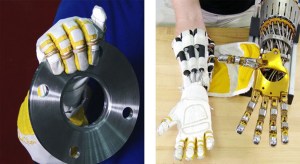
Evan Laske: Yeah. So that RSI, repetitive stress injury—a lot of effort when you think about it is focused on the repetition. A lot of us think that that’s the problem. Generally it’s the stress part of that. So if you’re constantly grabbing something and then manipulating it, it’s not the repetition that’s hurting you, it’s the stress. I’ll always like to give an example. So, I mean, no one is going to be able to see this, but make a fist. A loose fist with your left hand. And then squeeze as hard as you can with the right. Now start manipulating them around. Turn it around.
Host: So I’m just rotating my wrists right now.
Evan Laske: Yep. Now tell me what you feel in your right hand, the one that you’re gripping.
Host: I feel strong and powerful…not. [Laughs] I feel stressed. Yeah. Especially in my fingers, the stress is becoming much more apparent.
Evan Laske: And then all the way, it starts burning up through your forearm.
Host: Yes. Right. It’s going down slowly.
Evan Laske: All of that creates injury. And so your left hand, if you’re not straining it, you can repeat that all day.
Host: I forgot that this was here. I was definitely focusing on my right hand.
Evan Laske: Yeah. And so that was basically the idea is can we offload that strain part of it to a robot basically that you’re wearing and then you’re just dealing with the repetition.
Host: Okay. So you’re still rotating this and I forgot about my left arm cause I was so relaxed over here. But the grip strength is enhanced and supplemented by the robot glove.
Evan Laske: Exactly. It offloads the stress so that way your repetition doesn’t cause injury.
Host: Okay. Sounds really useful for—we talk a lot on this podcast with about spacewalks. We’ve had a lot of episodes on spacewalk and the whole gripping thing is huge. Cause in a pressurized glove, that gripping strength, even just subtle movements, you have to have a lot of stress in order to move different things. And so this can be an excellent way to supplement that. But I guess, you are thinking beyond, cause you said there was already some technology transfer and stuff into industry, right?
Evan Laske: Yeah so actually, there’s a commercial product. So this was actually a collaboration with one of our previous partners, GM (General Motors). Together we patented those and licensed that to a company. I forget the name off the top of my head. BioServo, I think is the name of the company. And they’ve brought a product to market for factory floor operations and things like that. It’s great.
Host: Okay. So factory workers on the assembly line, repetitive movements, exactly what you’re describing. Just a little bit of assistance for them.
Evan Laske: Exactly. Since then, we also had a project where we took that concept for Roboglove. You’ve mentioned spacewalks and we did apply it to a spacesuit glove. We actually did, circa 2014 to ‘16 or so. We were working as part of the high-performance EVA glove project, trying to adapt that technology to a spacesuit glove. And we took a different control paradigm with it because our goal was to maintain. You’re not just kind of on and off. You’re not gripping something or not. You’re constantly trying to fight the force of the pressure in your gloves. So we changed the paradigm in which we were operating and basically made it like power steering for your fingers.
So we would rely on the pressure of the glove to act as return force, but then we would pull what we call to flex the glove by each finger. So we’d pull on your finger as we sensed you moving in the glove. So we’d sense your finger moving, and then start. Just like power steering, as you start turning to the left, it starts assisting you turning to the left and offloads that force. And so vice versa, we sense you were leaving, we’ll relieve and let the pressure kind of come back. And so we were actually able to offload and see some fatigue release from that.
Host: Oh, wow. That sounds hugely beneficial. And I think this kind of leads us into a nice conversation with what we’re eventually going to talk about here is Valkyrie. But let’s keep going. Still a high level, right? We got to the dexterous part and really helping to define what dexterous means. Now humanoid robots. Let’s start there. Why is NASA playing in the space of humanoid robots?
Evan Laske: So the broader question is “why humanoid robots in general?” Why do people want humanoid robots? Generally, what’s good about humanoid robots, generally, is all of our spaces are designed around humans. You know, we evolved, of course, over time to have what we have for eyes and ears and hands and whatnot. And we built our buildings, our cars, our spacecraft, all around humans, right? And so they’re roughly human size. You know, they have human-sized openings and human hand-equipped interfaces. And so, generally what’s good about humanoids is that you sort of don’t have to think about some of those problems, because generally, if it’s a human scale has human-like features, you obviously are set up to be able to solve some of those problems. It doesn’t solve all the problems, let me be clear.
Host: Sure, sure, sure. Otherwise, we’re talking about like, what was that one movie, iRobot? It’s just a whole next level. But yeah, I get it. It’s like if we had doors that were super thin, and the handle was on the floor. It’s not designed for humans. It’s not really thinking about something convenient. But the doors are as wide as they are with the handle where it is, because our hands reach there and we can walk through when we go in. So instead of redesigning a whole environment, you put a humanoid in there, humanoid can open the door, and it’s relatively the same function. It’s built to function in a human-built environment.
Evan Laske: Yeah. I think the key here is it doesn’t solve all the problems, though. You still have a lot of problems that need to get solved cause one of the best things humans have as their tool is not necessarily their hands, it’s the brain attached to them, right? So we can solve problems, whether it be the latches stuck on the door or things like that where robots, you have to now handle those kinds of things. Even simple things like that we don’t have any issues coordinating with our hands, an air hose, how you have to pull off, pull the deck back on the collar and then insert, and then let go of the collar. That’s a really complicated thing you do with your hand. You don’t think twice about it. But to basically program a robot to do that still is complicated.
Where there’s a lot of choices that we could make in, you know, in spacecraft or the things around us, like different warehouses, you know, they use barcodes or other things like that to make things easier to track and whatnot. Doing some of those accommodations for robotics within your systems actually helps with the robot actually performing those tasks. Cause you can start relying on some things. But what’s great also is usually if you make things easier to manipulate, they’re easier to manipulate for a human too. Make an air hose easier to not have that complicated pullback on the—
Host: Three-step process, yeah.
Evan Laske: Yeah. It makes it easier for you to also make those. So there’s an interesting trade especially when you talk about just like there is between any complex system, spacecraft. You know, how your ECLS system affects your power system, things like that. Any complicated system has a lot of interactions.
Host: I think this sort of leads nicely into the complication of humanoid robots, right? Because what I was talking about at a surface level was just something shaped like a human, and fingers, toes, hips. Butt one of the things you brought up that’s very clear is the smarts the brain. It’s a whole level of complication to program all of the different features of a human, the hands to make all those dexterous movements. So your job is very multi-layered in the fact that you have to think about every intricate part of a design, the feet, the hands, the torso, everything. But then making that all gel and making that robot be able to perform human tasks sounds like a whole other level of complication. If we were to just talk about the brain on this episode and like what goes into coding a humanoid robot, I feel like this could be all day. We could be talking all day.
Evan Laske: Oh, I’m sure we could fill eight hours’ worth of conversation about robotics. That kind of brings us to the fact that humanoids aren’t the only robot archetypes that are dexterous. We abstract that a little bit, especially where NASA’s potential advantage of having robotics within their architecture for missions, especially human missions, right? They’re designed around humans. Crew systems. So human scale, robotics is sort of that zoomed one level up. You don’t need a humanoid necessarily to do certain things, right? It has its pros and cons, the complexity of the system and it solves some problems. But manipulation generally is what humans do, right? We don’t just sit there and pilot a spacecraft with our minds, although that would be cool. We push buttons, we open doors, you know, perform experiments, right? It’s manipulation where the worst thing is we have to deal with a lot of logistics, right? That takes a lot of time and effort on long-duration space missions. I mean, think about the logistics just on ISS. All the stuff, the stowage that’s on board.
Host: Okay. You’re talking about when a cargo mission goes up to the space station, now that cargo has to be unloaded and transferred, documented, inventoried. That’s what you mean by logistics.
Evan Laske: Exactly. And so on something like the ISS where you’re crude all the time, it’s really easy to have the crew deal with that. But architecturally, where we’re interested in exploring is how that fits into the sustainable surface operations on the Moon, right? When we’re delivering logistics there, do we need to spend time with EVAs to go grab all the logistics and bring them back to base just so that way, you know, you can now live for your two weeks there. Or would we rather have them set up for the crew nearby or something like that? And that’s something where we think robots may be useful in mission architectures of the future.
Host: Okay. Yeah. So example, you have a mission for two weeks, you have X number of EVAs that you want to perform. Let’s just throw out six. Instead of dedicating one or two to logistics and four to science, you can dedicate six to science and then you can just do the logistics one completely robotically.
Evan Laske: That would be, in our view, a great business case for robotics on the surface. Because that allows us—think about how much effort that time, money, resources, that goes into an EVA. And certainly, we would never want to replace humans, you know, in any of these mission architectures, we want to optimize their time, right? Because what do those two EVAs cost? And the amount of scheduling, the amount of resources just to also get those resources, right?
Host: Right. Right.
Evan Laske: So something where we see a lot of robotics in the future. I mean, you see a lot of discussions about ISRU or in-space resource Utilization. A lot of those might be rovers or other type of plans, you know, architecturally it’s TBD. But utilizing those resources, getting the logistics, that’s where basically human-scale robotics is useful, right? Because we can make sure the crew is doing science, you know, and those mission objectives.
Host: And then you have a robot turning dirt into fuel or something like that. Or dirt into oxygen.
Evan Laske: Yeah or taking out the trash.
[Laughs]
Host: Taking out the trash. Okay. Yeah. Alright, I could see a use for this on Mars. I could see a use for this in my own house. Any supplementary to save me time to save the crew time. Very useful. This is sort of why we explore this technology. It is, let’s just see how we can develop this and how we can better support our crew and the missions. And so this is the technology exploration. This is so cool. Your role is really—let me know if I’m simplifying this too much—is like, “hey let’s see how far we can take this, let’s see how far we can push this technology. Let’s see how far, let’s see how much we can help NASA and humanity here on Earth.”
Evan Laske: Yeah. I mean, our team especially is kind of—I may throw out some jargon here—in the Technology Readiness Level, or TRL. There’s a scale from one to nine, right? And nine being we set footsteps on the Moon, and one being I have an idea in a lab. I have some sketches. Let me see if I can try this out. Somewhat sort of in-between is where you kind of progress. Oh, I’ve verified. I understand the concept. I’ve tested it out. I’ve made a prototype of a thing that uses that concept, you know, et cetera. And we play in that TRL three to six. So what that means is basically things that are just coming out of research in universities, and then we do those proof of concepts, and we do the integration of maybe multiple ideas within that lower TRL scale. And we put them together and we do some of those the first time. And then we go all the way up to basically six or seven where you’re actually taking that concept and getting it into a relevant environment.
For example, with Robonaut, we were actually able to launch a torso up to the International Space Station on STS-133. Then in 2014, we added legs to it. And we were able to basically get some of that technology in the torso, for example, up to TRL seven basically. So the first time we were able to do dexterous manipulation with some of the items and running that software in space. So that’s what that seven. It was a great opportunity to do that.
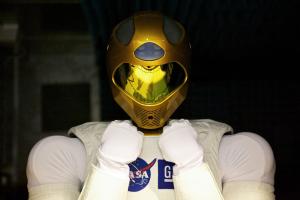
So some of our work stems all the way down to research, all the way up to early spaceflight technology demonstrations. You asked me earlier a little bit about how much through that scale, all the things that go into robotics. So we have tested, our team has worked with different, what we call end effectors or tools. Think about them as hands, different types of hands, whether they’re two-fingered, five-fingered like human hands, or somewhere in between. We’ve also looked at the manipulator controls themselves. How you move an arm in space, in 3D space that is. And also how you then create what we call behaviors. So those are the little building blocks of things that you would do. It’s kind of like little instructions you might tell your own brain to do, like, “identify where the water bottle is,” and then when I know where the water bottle is, “okay, now grab the water bottle, now open the lid.” Now those are each individual behaviors that you can then start planning bigger and bigger things out of. And so that sort of software level of integration and testing, where we’re actually doing a lot of our work right now, is those kind of behaviors.
Host: Huh. Okay. What you’re saying is you’ve done a lot of the work to feel like what’s the best hand and then design that, test that. Now it’s really all the program of on the podcast, I am now grabbing my water bottle. I am doing all of those things. And to me, it’s one fluid motion, right? As a human who has done this countless number of times. But you’re going into each intricate step now and trying to make that more fluid, better. Think about all the risks of what happens if you bump the table, how does the hand reset and try again? Or something like that. That’s really where a lot of your work is.
Evan Laske: Exactly. So right now we’re doing a lot of that behavioral generation for a relatively simple when we consider the complexity of a humanoid. So we’re actually able to do that within the context of, space missions and that kind of thing with prototypes and other things like that, and concepts of what an inside of a vehicle might look like. That’s one of the big efforts we’re working on within that NASA asset context. Of course the question is, “where does Valkyrie fit into that?”
Host: Oh, you are perfect at that. That was exactly my next segue was “let’s go into Valkyrie.” Okay. So we’re talking about dexterous robots, we talked about Robonaut 2 and then there are other humanoid robots. The title of this episode is “Valkyrie.” This is one of the robots you guys are working on, and there’s a lot of cool stuff that has been happening recently. Just 2023, we’ve had a couple of announcements on some progress and partnerships you guys have been making. Let’s start high level though. We’ve been talking dexterous robotics, humanoid robots. What’s Valkyrie?
Evan Laske: So, Valkyrie, the history of Valkyrie. She came out of the DARPA Robotics Challenge. So the DARPA Robotics Challenge, at the time, was in response to the Fukushima disaster from the tsunami in Japan.
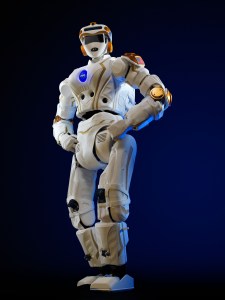
Host: Okay. Nuclear plant?
Evan Laske: Exactly. And so out of that, DARPA said, “how can we solve this? Instead of having people go in to these kind of disasters, can we solve this with robotics?” And so they created this challenge in roughly 2013, I can’t remember exactly the year. Valkyrie was basically our entrant to that. We designed and built her in roughly to the form she is mostly today, 12 to 18 months. That included all the hardware, all of the system design, all of the software as well. There was a lot of work that went into beginning that. So we performed in the DARPA Robotics challenge. And we have since been doing various partnerships with other researchers and other things like that and have really used her as a research platform. So we actually really like to bring NSTGRO, or NASA Space Technology Graduate Research Opportunity students.
Host: Of course, it’s an acronym.
Evan Laske: I mean, the fact that it’s an acronym you can say is an actual acronym, right?
Host: It’s impressive.
Evan Laske: Yeah. It’s pretty good. Because we play in that TRL three space, you know, it’s a great opportunity to bring researchers in and use Valkyrie or other systems we have around as a platform for advancing the research side of robotics. In addition, we’ve been working on various partnerships with, for example, IHMC, which is out of Pensacola, Fl. They’re basically who has implemented their walking controller which is what you need for a humanoid to walk around. They have implemented that on Valkyrie and that’s basically our core whole body, we call it “controller,” that we use as the core of the robot. So it’s been a really beneficial relationship over the years. And they’ve got, you know, 25 years of experience and walking algorithms and other—well, I think my 25 is up closer to 30 at this point, and—
Host: Oh yeah cause that was at the time, right?
Evan Laske: That was circa 2015 or so, so yeah. That’s one of the critical components. And so what have we been up to with her lately? We’ve been trying out different end effectors. So we designed and built to the technology and the research of the time. A hand that was more robust than Robonaut’s hand cause it was meant for the Fukushima kind of level of manipulating valves and, you know, other things like that you might have to do to shut down or react to a nuclear plant. We developed a lot of behavioral technologies and other things like that, that have spurred a lot of development. We’ll throw out a robotics buzzword of Affordance Templates. I won’t go into that here. That’s a whole episode. But that was around the same timeframe, like that came out of research. And basically having that platform now allows us to actually develop, more recently, sort of situational awareness for the operator. We actually now control Valkyrie most of the time through a VR headset.
Host: Oh, that’s cool.
Evan Laske: Yeah so what’s really cool now is you put this VR headset on, you got your hand controllers, and you see through her eyes. And because she’s humanoid, this is one of those advantages. We kind of all understand how a human’s supposed to move. So it makes it a lot easier to teleoperate. So what we do is we can actually use the human executive, that human brain that we were talking about before, and then we can try out different things with the robot, and then we can find out different methods and then figure out, “hmm, how could we make this easier for the robot to do, or for a human to do? And how can we encode those behaviors? How can we create driver assist tools for a human operator of a robot or other things like that?” So that’s kind of a lot of what we’ve been doing with Valkyrie as of late.
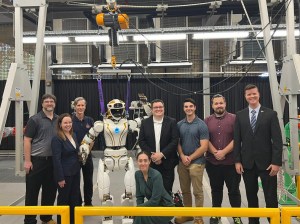
Host: Awesome. If you ever need a brain to sit in and teleoperate a humanoid robot, and it needs to be a lower fidelity brain, you got one right here. This is awesome. So you mentioned the technology development, whatever 10 years ago, 2013. That’s 10 years ago. I think we were saying five. It’s just like, oh, wait. Yeah. I think more time has gone than we probably think. Yeah. But that’s a decade. When you say swapping out an end effector, let me go back on this. Swapping out an end effector, you mean removing a hand and gauntlet and putting a new one on?
Evan Laske: Basically, yeah. So in robotics, we generally talk about the end effector or use the term “tool.” Yeah, yeah. Because especially where most robotics is in automating of manufacturing and other things like that, right. How it comes into industry. So you generally have some sort of tool on the end. In our case, it’s usually general purpose manipulation or something similar to that where you have a hand-like object of some kind, whether it be two fingers, three, a whole five fingers, you know. Posable thumbs.
Host: Those things.
[Laughs]
Evan Laske: Those things. Those things that are useful. We can kind of talk about those as end effectors or tools, you know, we use the term. So what we do now is kind of look at the technology in 2013 and even just the sensor technology that’s in Valkyrie for sensing effectively touch that was based on a paper out of 2012, circa 2012, right? When we look out there now a lot of industry has kind of caught up with that technology. Now you’ve seen Boston Dynamics, you know—
Host: Yeah, the robot that does the flips.
Evan Laske: Exactly. So that’s hydraulically operated. So in the future, we look to see more electrically operated. I mean, you think about all the things that go into building something for the Moon or something like that in the future. Generally, all our robots are electrically operated, our vehicles for that, you know, have batteries and are electrically operated. You know, aside from the rocket on the end. So there’s other that have brought things to market, the many different robot Quadrupeds are out there. Quadrupeds being like the robot. Dogs. Dogs,
Host: Dogs.
Evan Laske: Dogs, yep.
Host: I was about to say dogs. Yep.
[Laughs]
Evan Laske: And there are others that have brought humanoid-like things to bear. In fact, IHC’s partner, has built their own humanoid-like robot. What’s interesting about that is we’ve looked at actually the prosthetics industry. The prosthetics industry has been looking at how to give people more dexterity. Again, dexterous robotics team. And we actually found a commercial product that is an order of magnitude cheaper than the bill of materials of a Valkyrie hand.
Host: Interesting.
Evan Laske: But it’s commercially available.
Host: Wow.
Evan Laske: And we were able to basically buy one, put it on Valkyrie and see how it performed.
Host: Let’s try it, a commercial off-the-shelf hand.
[Laughs]
Evan Laske: Yes, exactly. Exactly. It’s pretty great. Five fingers and everything. And coincidentally uses a lot of the same sensor technology from that same 2012 paper.
Host: Oh, wonderful.
Evan Laske: So it’s really cool to see that kind of come along. That’s what happens in 10 years.
Host: Not only does technology progress, but it becomes more accessible and affordable. But just by paving the way right now, you can now have these options. Oh, that is amazing.
Evan Laske: I’m really excited to see what the next 10 years look like for robotics, especially human-scale robotics, whether it be humanoids or, you know, Robotics for the lunar surface. I’m really excited to see how industry advances that and steps up itself.
Host: So 2011, you got here full time and joined the dexterous robotics group? Or was it 2013?
Evan Laske: It was 2011. I was a co-op still at the time.
Host: You were a co-op still at the time. So I mean, even then, because that was when you were seeing it. Timestamped 2011 to 2023, that progression, if you take that as a whole snapshot, has it been crazy growth that makes you excited for the future?
Evan Laske: Oh yeah, absolutely. I mean, you look at how many things are coming online from different groups. I mean, you think back to 2011 and my memory in years may be failing me, but you look at the Quadrupeds that are out there.
Host: Dogs.
Evan Laske: The dogs, again, Quadrupeds.
[Laughs]
Host: I’m sorry, I’m not going to do that, I’m not going to say the, the fancy term. I’m going to say the Robodog man. The Quadrupeds, okay.
[Laughs]
Evan Laske: For those following along, quadra: four; peds: legs.
Host: Alright. Alright. It’s a little higher fidelity than that, Evan. Come on.
[Laughs]
Alright. So the Quadrupeds, yes.
Evan Laske: So in any case, I remember seeing those. You know, we’ve all seen those YouTube videos and mind you, 2011 is after YouTube started so that’s good. But you see those and where they came from then they’re on the market and people are implementing them in so many different places. You know, different environments like industrial environments, construction environments, things like that. Now seeing that with space robotics and seeing where that’ll go and seeing where humanoids will go. You know, we had that and we saw that with the hands, but we’ve also found that with the robot itself.
Host: Okay.
Evan Laske: So we had a partnership relatively recently where we had started looking at what it would take to build a newer version, take all the lessons learned from Valkyrie, and try to solve those. And when we started doing that, we started addressing some of the limitations, dealing with the requirements and figuring out how we would solve the problems. Then in around, I think it was the end of 2021, we met up with one of the people that actually, as a SBIR, Small Business Innovative Research—this is a government-wide program to—
Host: To encourage small businesses to partner with the federal government?
Evan Laske: No. To build technologies that the government wants.
Host: Oh. To have small businesses do that for us.
Evan Laske: And then they can take that and use it for a commercial product. Ideally at the other end of it, it’s something NASA wanted and NASA can now buy, right?
Host: Okay. Yes.
Evan Laske: So in around 2016, I said we were using it for those research things. One company had a Small Business Innovative Research phase one with us, and we got to talking with them again and it turned out they were doing a lot of the same things we were going to do. They were like, “hey, we really want to make humanoid robots that don’t just dance and flip, that perform tasks in an industrial settings and very similar settings to what you might see in spaceflight.” Now, of course, space and lunar creates a whole other dimensional complexity of dust and vacuum and other things like that. But they’re like, “we really think we can make a product out of a humanoid robot that can perform tasks at a human scale.”
So we started talking with them. Basically, we saw that and we decided to leverage the SBIR program to start working with them, developing requirements for what that might look like, you know, infusing some of the lessons learned we had with Valkyrie on operating her over 10 years. And recently they have debuted their robot. So you can actually find that, what they’ve been working on at their website. The company’s called Apptronik. And we’ve been working with them since then and we look forward to working with them in the future.
Host: Wow. So beyond this relationship, you’ve sort of been addressing this throughout our conversation, but I just sort of wanted to bring everything together and just talk about the benefit of not just kind of working on a humanoid robot in a “bubble,” but to look at industry and information share and learn off of each other. Do you find that these partnerships help to accelerate the technology as a whole in a sense?
Evan Laske: Absolutely. Our team really gets a lot out of advancing that. So NASA gets these technologies advanced through, you know, universities and what have you. And really our team provides that link to NASA. You know, we actually serve as usually technical monitors. That’s the term for people assigned to keep tabs on the SBIR’s.
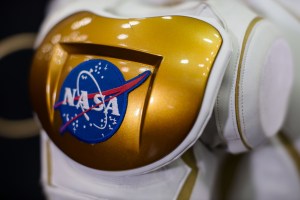
Robert Markowitz
Host: Technical monitors. Okay. Like checking in, how you doing kind of thing?
Evan Laske: Yeah. I mean, it’s basically a relationship that allows them to ask us questions and we make sure, you know.
Host: Oh, okay. A point, almost like a NASA point of contact for anything.
Evan Laske: Exactly. And so we’ve actually had one recently with another company, Picknik Robotics. We’re using their product now in trying to do motion planning and those behaviors that we’ve been talking about. So how do we encode behaviors? So we’d done previous research on how we would might do that. We actually built a tool, it’s open source called Task Force, that actually descended from the Valkyrie DARPA Robotics Challenge.
Host: Oh, how about that. Cool.
Evan Laske: Yeah. So that’s been out there. And some of the folks within Picknik are familiar with that as well. And they’ve built now a commercial product that effectively tries to put together behaviors and make a good user interface for them. And so we’ve looked at that as an interesting model because their approach is open core. What does that mean? They’re building on open source tools that they contribute to, and then they layer their commercial secret sauce on top, right? So they sell a product, but they still improve these open source tools that are beneficial to everybody. And that’s something like for us, too, we open-sourced Task Force and other things like that. And we really hope those kind of things bring up the whole technology development. It shows how that technology can advance and then percolate across the robotics community and then come back around to companies building something for spaceflight.
Host: Okay. So you’re doing quite a bit there, and it sounds like the brains are a big part of it. The coding, the behaviors being the pickup the water bottle and drink it sort of behavior, those sorts of things.
Evan Laske: No reason you want to talk about that.
Host: Just getting thirsty having this conversation. Another one that I thought was interesting was, I saw this one recently with Woodside Energy, you got to actually go to Australia. What’s this partnership?
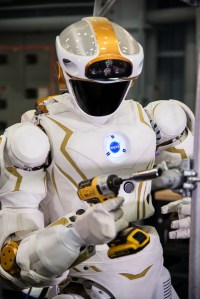
Evan Laske: Yeah. So this partnership, you know, we mentioned earlier the sort of discussion about all the different places that people are deploying robotics, especially in dangerous environments. They’re really interested in whenever you have a person in a dangerous environment, the question is, “how can I minimize the risk for that person?” Right? Spaceflights always going to be inherently dangerous, right? But it classifies as a dangerous environment, right? Similar dangerous environments might be oil and gas or petroleum infrastructure. If you’re processing something like natural gas, you’re around a lot of flammable stuff all the time. And there’s a lot that goes into keeping those kind of facilities safe. Just like a lot goes into keeping spacecraft and ECLS systems alive and that kind of thing. The question is, how do you deploy robotics within those missions and those architectures? And they’re very similar to deploying them to an oil and gas facility as it might be to potentially deploying them within mission architectures. So both NASA, and in this case, Woodside, were really interested in deploying robotics. How do we deploy those in those mission architectures? How can we integrate, you know, autonomy in various ways into how we operate? And we’re also interested in that kind of thing.
So we actually had an initial Space Act Agreement with Woodside from about 2017 to 2022. And that was sort of centered around, cognitive robotics, right? How do we link the manipulation things with the system interface? So they have their own system, sort of mission control interface and that kind of thing for their plants. How do we put robotics into that kind of thing? How do we deploy them? As part of that they actually were looking at Robonaut and kind of just the manipulation aspect of it and I was actually able to go down there to loan them, Robonaut 2. We actually loaned them one for the past few years as well as I was able to sort of second into their into their group for like three months in 2018.
Host: Yeah. You went to Perth, Australia.
Evan Laske: Yep. The Woodside is in Perth, if I get my pronunciation right. The Australians are probably—
Host: They roll their eyes.
[Laugh]
Evan Laske: Either judging or not. So I was able to kind of stay with them for three months and work with them on their problems and kind of take their lessons learned. Things that we learned operating those robots in those environments, and then take them back to what we were doing in task and behaviors and how we constructed them and how those link together and benefit from those lessons learned. So it’s a really unique way to get—before we go to deploy things in space—experience on how those things integrate. So we recently—I say recently, it’s been over a year now—signed a new Space Act Agreement with them because the same alignment was still there. Part of that centered around, okay, so now we’ve kind of started deploying robotics to this, how can we start adding some of those mobility and manipulation and things like that and get prepared for that 10 years down the road when we’ve got humanoid robots taking out or trash at home, right? How can we make them do things in a dangerous environment? How do we deploy them? And so that’s kind of where Valkyrie steps in. Okay, here’s what it takes to operate and deploy Valkyrie, you know, that kind of thing. And now Valkyrie is never going to go to an oil and gas plant itself. It is a very tethered research platform with its own limitations, as we talked about. But this gives folks at Woodside the opportunity to kind of learn that paradigm. And it gives us the opportunity to get more lessons learned with respect to how you deploy those.
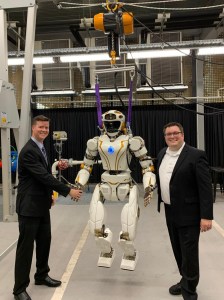
Host: Yeah. It’s almost like a jump in progress a little bit just by having that experience and kind of working together, you can come back with lessons learned in a short three-month time period than if you were to try to maybe do it on your own. Just those partnerships that kind of accelerate NASA, accelerate the business. We talked about those small business partnerships and stuff like that. So it’s all, it’s all just accelerating progress so you can get to that 10 years.
Evan Laske: That is the goal. You know, what came out recently was we actually visited in March to deliver or loan them a Valkyrie unit for them to try and operate in their lab. So was able just more recently to go. And that’s what story was on the NASA website recently. Which was a great experience. We did go up to their facility, you know, and see what kind of things, just like spending time on EVAs just for logistics was kind of a good opportunity to optimize cruise time. There’s a lot of dangerous environments which are way too hot or way too dangerous to be in. They do a lot of work to deal with those and make sure people are safe. And their thought is it would be nice if a robots could do that. And then we can do the, for lack of a better word, important things.
Host: Right.
Evan Laske: So that’s the kind of thing we’re aligned with in that regard. We hope that the lessons that we can learn through working with them with Valkyrie give us better insight into what other problems we might need to solve between here and that 10-year time horizon.
Host: When you think of Valkyrie’s legacy, because I think the theme that you mentioned that’s pretty important is, and we see this a lot, is you want to look at a Valkyrie, you want to look at this really cool looking robot, be like, “we’re just going to continue to improve that robot, and then that robot is going to be ready to ship out.” But you just said that Valkyrie, in and of itself, is a technology demonstration. And whatever does end up solving those needs for whatever it may be in Woodside, for dealing with the dangerous environment in oil rig, or in Apptronik for whatever they’re going to be doing to solve some sort of business needs, some issue or whatever ends up on the Moon or Mars, you know, it’s going to be its own thing. But at the end of the day, what do you hope the legacy of Valkyrie is? Looking back and spending so much time and effort and passion on this particular project?
Evan Laske: Well, it’s an interesting question. You know, at the end of the day, as I said, I look forward to seeing what 10 years from now we have available. Right. Valkyrie is a stepping stone to that, it’s just one robot, you know. And we require a lot of different robots and as I said, different archetypes, to really explore how we can solve those human-scale problems. Humanoids are one of them. Valkyrie’s got already a storied history. We’ve got a lot of people that have referenced it over the years and provides a lot of inspiration for how others kind of view robotics and that kind of thing. And so I feel like its legacy has sort of already been written. It’s kind of pushed that boundary forward and, you know, the next stage of humanoid robots and the technologies that stem from them and other manipulation, you know, we’re going to be leveraging those things for years to come.
It’s kind of neat having 10 years on, seeing things like ROS, or the Robotic Operating System. Basically it was a concept that came out of a company or organization, Willow Garage, about how can we make it easier for all this software development for robotics to not be bespoke to just one robot and just iterate on that robot forever and share that technology. And it exploded the research in robotics and the leveraging and integration of each other’s software to enable the software to be where it is today. And what’s interesting is that recently there’s been an uptick of interest in space robotics. For example, there was an ACO or Announcement of Collaborative Opportunity, with NASA that actually just wrapped up where Blue Origin and Open Robotics, the company that maintains ROS now, although they’ve now been bought by Intrinsic, or they’ve been bought by Google, Intrinsic is the company name now. But Open Robotics still is the open source version of it.
So Blue Origin and Open Robotics had this collaborative relationship with NASA that started developing a space ROS. So the idea being to try to start layering on top the things that they need to be able to bring robotic technology that is built for the ground and make it a lot easier for people to bring that forward and lower the barrier to entry to taking software written for robots here on the ground that’s, you know, doing those back flips. It would be a shame if you had to rewrite all that software to be flight-ready and how can we make that easier? And that’s what space ROS has been looking at doing. And so, I’m excited to see how that sort of fits in with all the robotics that is happening because then all that starts to be able to get transferred to all the stuff we’ve been doing on the ground. Makes it a lot easier to transfer that to space, transfer that to future missions, onto the lunar surface, onto Mars. A lot easier when you don’t have to rewrite your very complicated behavioral systems and everything like that.
Host: Yes. That’s huge. Let me give you an example and you let me know if I’m interpreting this right. The idea of let’s just say back flip on Earth, how much time and effort it’s taken to make sure that that goes well, not to start from scratch when you want to do that on the Moon in one sixth gravity, that’s what you’re saying. You’re saying making it easier to translate the Earth-bound behaviors to the space-bound behaviors.
Evan Laske: So that’s part of it.
Host: Part of it, okay.
Evan Laske: But also the software underneath it. So in order to make behaviors work, it’s like there’s an operating system underneath, right? Although ROS isn’t an operating system, it’s sort of like that, right? Imagine you built this fancy software on Windows that makes the robot back flip. It would certainly suck to have to rewrite that. So it’d be nice to have. And so the idea behind space ROS was how can we make that transition easier? So we can go from a ground level of software development, we just got the thing working for the first time to, “okay, now we have to make sure that it works in space every time and doesn’t crash.” How can we make that simpler?
Host: Interesting. Evan last question, and I think it’s been a theme, an underlying theme through much of this conversation, but I definitely want to hear your perspective on this because I think you might understand it more than most. When we talk about exploring space and solving these issues for spaceflight needs, remote operation and making sure that we have, you know, like a Moon habitat taken care of when humans are not there, supplementing their workday and moving some cargo while they’re off doing very important science. When we think about those needs and the marriage of investigating and trying to solve the problems to meet those needs and the needs of us Earth-bound citizens here on the ground, and what robotics can do to solve that and how the relationship of solving problems in space helps us on Earth. When you try to capture all of that and say, “this is why spaceflight is important because it benefits all of us,” how do you usually try to capture that?
Evan Laske: Well, I’ll say that that is actually one of the most important things I feel like with NASA investing when they can in advancing robotics. Cause it’s just like everything. I mean we’ve talked about how Roboglove and a spacesuit Roboglove before, right? They’ve not been commercialized into something that can assist in relieving stress injuries from people. You know, that’s not something you would’ve thought of when we were building a caretaker-robot concept that was R2. Right? So it’s really hard to say how much until years on how much you’ve influenced sort of life on here on Earth, but there’s no denying that we do. Throughout all of the things that NASA has done throughout spaceflight, throughout robotics, those items, those technologies make their way out and percolate. And then you don’t know now how one idea might spark something completely, new 10 years from now. So though we never can know kind of like how much we’ve influenced life here on the ground, we try to measure that and that kind of thing. We don’t know at the time how much we’re going to.
Host: You do your best, you put one foot in front of the other and then you look back and you say, “oh, I think it turns out a lot of this work ended up benefiting whether it was.” You know, you didn’t really have this grand plan of working with all these different companies and having these relationships and putting out open-source information only for people to build on top of that and share that information with one another to build up the whole robotics industry. It’s hard to see at the time. You maybe have an idea, but to see how much has progressed is it’s kind of like the approach is just keep doing it, keep putting one forward in foot in front of the other cause you know that’s part of the goal here.
Evan Laske: Yeah. I mean it is, honestly, that is one of the things that personally motivates me a lot. The work that we do here at NASA, you know, across everything that we do, which is extremely varied, right? All the way from ISS to flight research to robotics, you know. When I look back, 10 years from now, 20 years from now, you know, 30 years from now when I retire or what have you, it’ll be really cool to see where any of the technology my hands got to touch has gone. Cause there’s no knowing right now where it’s going to go, but I’m sure I’m going to be really, really happy when I get there.
Host: Evan, that’s the perfect place to end this conversation. Evan Laske, thank you so much for coming on Houston We Have a Podcast and sharing your passion for robotics that has influenced, you know, much of what we do here at NASA, but also the economy and places around the world. Thanks. Thanks for coming on and sharing what you do.
Evan Laske: Well, I appreciate it. Thanks for having me. It was good to finally again cross paths professionally.
Host: Absolutely. We’ll meet again in 10 years. You can tell me how we do.
Evan Laske: Let’s mark the calendar now.
Host: Let’s mark it. Yes. Awesome. Alright, take care, Evan.
Evan Laske: Thanks, Gary.
[Music]
Host: Hey, thanks for sticking around. I had a blast talking with Evan Laske today about humanoid robots. Really learned a lot, and I hope you did, too. You can check out nasa.gov for the latest. We mentioned a couple of the awards and partnerships that have been mentioned, and you can check them all out at that website. You can also listen to any of our NASA podcasts, the full collection at nasa.gov/podcasts. That’s where you can find us, Houston We Have a Podcast and listen to any of our episodes in no particular order. If you want to talk to us, we’re on social media. We’re on the Johnson Space Center, pages of Facebook, X, Instagram. You can use #AskNASA on any one of those platforms to submit an idea for the show, just make sure to mention it’s for us at Houston We Have a Podcast. This episode was recorded on September 8, 2023. Thanks to Will Flato, Justin Herring, Dane Turner, Abby Graf, Jaden Jennings, and Rebecca Wickes. And of course, thanks again to Evan Laske for taking the time to come on the show. Give us a rating and feedback on whatever platform you are listening to us on and tell us what you think of our podcast. We’ll be back next week.


























